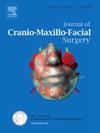A morphometric analysis of the cranial base in trigonocephaly
IF 2.1
2区 医学
Q2 DENTISTRY, ORAL SURGERY & MEDICINE
引用次数: 0
Abstract
Trigonocephaly occurs when the metopic suture fuses prematurely. Few studies have documented the morphometry of the entire anterior cranium in trigonocephaly and not on the morphometric changes to the cranial fossae alone. Thus, this study aimed to determine and compare the dimensions of the anterior cranial fossa (ACF) in trigonocephaly and control groups. Additionally, volumetric assessments of the middle and posterior cranial fossae (MCF and PCF) were analysed to determine the amount of compensatory growth in these regions. Anatomical landmarks were used to measure the morphometry of the ACF, and volumes of the MCF and PCF on preoperative two-dimensional computed tomography scans of fifteen non-syndromic, isolated trigonocephaly patients between 2012 and 2023, and eight controls. Comparative assessment of the ACF revealed larger dimensions in younger more severe trigonocephaly patients when compared to the control cohort. Smaller ACF dimensions were recorded in older patients who presented with moderate and severe trigonocephaly compared to the control cohort. The volume of the MCF was found to be significant (p = 0.05), and the volume of the PCF was larger in trigonocephaly patients compared to controls. The PCF showed the largest incidence of compensatory growth (30.4%) in trigonocephaly patients. The frontal angle (FA) (p = 0.004) and endocranial bifrontal angle (EBA) were used to categorise the severity of trigonocephaly. The morphometric data obtained could assist craniofacial surgeons in understanding the changes that occur in the ACF to decide which type of corrective treatment is most suitable.
求助全文
约1分钟内获得全文
求助全文
来源期刊
CiteScore
5.20
自引率
22.60%
发文量
117
审稿时长
70 days
期刊介绍:
The Journal of Cranio-Maxillofacial Surgery publishes articles covering all aspects of surgery of the head, face and jaw. Specific topics covered recently have included:
• Distraction osteogenesis
• Synthetic bone substitutes
• Fibroblast growth factors
• Fetal wound healing
• Skull base surgery
• Computer-assisted surgery
• Vascularized bone grafts

 求助内容:
求助内容: 应助结果提醒方式:
应助结果提醒方式:


